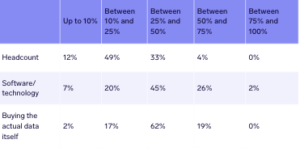- Spending on third party software systems for analyzing data will see the most growth over the next five years
- But many funds still rely on Excel, survey shows
Investment manager budgets for alternative data are set to increase further this year building on strong growth in the past two years, new research from leading alternative data platform Exabel and BattleFin shows.
RELATED: Optimizing supply chain resilience in Africa: Data-driven strategies for overcoming pharmaceutical and logistics challenges
Around 85% of investment managers and analysts questioned in the global study say budgets will rise this year with a third (33%) forecasting substantial growth, Exabel and BattleFin’s report Alternative Data Buy-side Insights & Trends 2025 found.
That builds on recent expansion in budgets, the global study with fund managers in the US, UK, Hong Kong and Singapore with total assets under management of $820 billion found. More than two-fifths (43%) questioned reported a budget increase of between 50% and 75% over the period while 36% said budgets had grown by between 25% and 50%.
Third-party software systems for analyzing data key area for growth
The research report from Exabel, which was acquired by alternative data provider Battlefin in December last year, found a key area for growth in budgets is likely to be third-party software systems for analyzing data.
Currently two-thirds (66%) of firms questioned use third-party software as part of their range of solutions compared with 51% who use in-house built systems and 51% using systems provided by data vendors. The research, however, found 59% still use basic tools and other legacy systems such as Excel and Tableau to analyze alternative data.
That looks likely to change – 85% questioned predict their use of third party systems will increase over the next five years with 15% predicting a dramatic increase in their use for analysis. It is seen as more cost-effective with 87% of those surveyed giving that as the reason for increased use of third-party software systems, while 62% say they are a more consistent way to work with different types of data. More than half (52%) say they are more effective than in-house systems.
Using alternative data for investment research
Senior management at firms questioned are supportive of increased budgets – almost all (98%) are very or quite committed to using alternative data for investment research. More than four out of five (84%) have an alternative data lead with just 11% admitting they do not.
When allocating budgets for acquiring and managing alternative data, the survey found around 62% allocated between 25% and 50% of their resources to purchasing the data while 45% say their firm allocates around 25% to 50% of the budget to technology and software. Nearly half (49%) indicated that their firms allocate 10% to 25% of the budget to headcount for analyzing and managing alternative data.
Tim Harrington, CEO of Battlefin & Exabel said: “The demand for alternative data continues to grow globally, with investment managers increasing their investments year on year to both acquire and manage a growing array of datasets.
“Key issues include resourcing, standardization of data across sources, and use of third party analytics tools. We are committed to leveraging the power of alternative data to deliver actionable insights and value. In today’s dynamic market environment, accessing high quality data is crucial for achieving a competitive advantage and unlocking alpha.”
The table below shows how firms questioned allocate budgets for acquiring and managing alternative data.





























